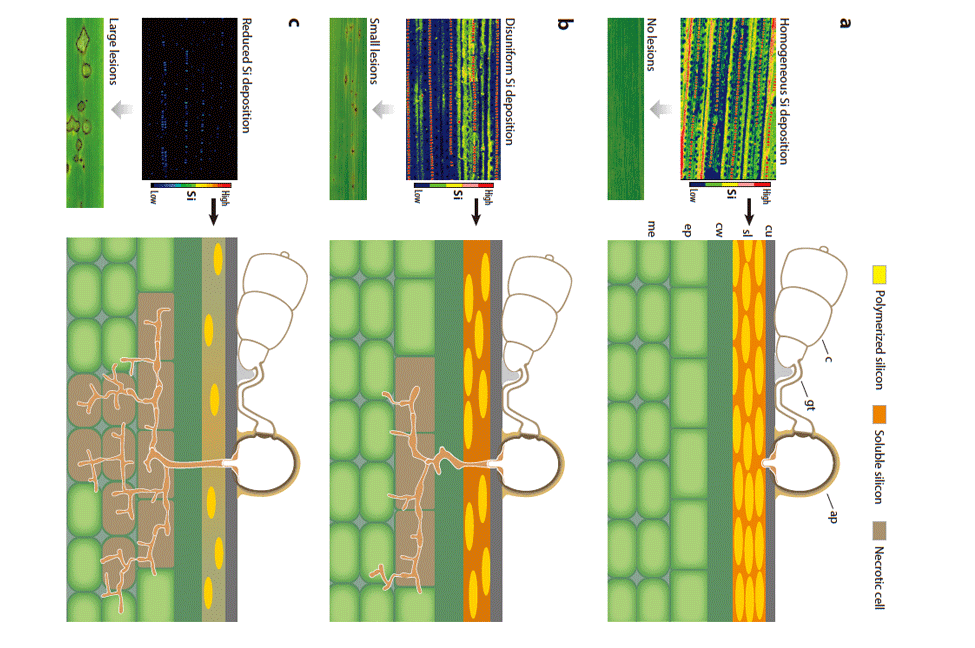博文
综述:硅在植物生物和非生物胁迫中的作用
||

Silicon's Role in Abiotic and Biotic Plant Stresses
Corresponding author: Fabrício A. Rodrigues; Lawrence E. Datnoff (路易斯安娜州立大学农业中心)
Silicon (Si) plays a pivotal role in the nutritional status (营养状况) of a wide variety of monocot and dicot plant species and helps them, whether directly or indirectly, counteract (抵消) abiotic and/or biotic stresses. In general, plants with a high root or shoot Si concentration are less prone to pest attack (虫害) and exhibit enhanced tolerance to abiotic stresses such as drought, low temperature, or metal toxicity (金属毒性). However, the most remarkable effect of Si is the reduction in the intensities (强度) of a number of seed borne (种子传播), soilborne (土壤传播), and foliar (叶的) diseases in many economically important crops that are caused by biotrophic (活体营养的), hemibiotrophic, and necrotrophic (死体营养的) plant pathogens. The reduction in disease symptom (病症) expression is due to the effect of Si on some components of host resistance (寄生抗性), including incubation period (潜伏期), lesion (感染伤口) size, and lesion number. The mechanical barrier (机械屏障) formed by the polymerization (聚合) of Si beneath the cuticle (表皮) and in the cell walls was the first proposed hypothesis to explain how this element reduced the severity of plant diseases. However, new insights have revealed that many plant species supplied with Si have the phenylpropanoid (苯丙素) and terpenoid pathways potentiated (增强) and have a faster and stronger transcription of defense genes and higher activities of defense enzymes. Photosynthesis (光合作用) and the antioxidant system (抗氧化系统) are also improved for Si-supplied plants. Although the current understanding of how this overlooked element improves plant reaction against pathogen infections, pest attacks, and abiotic stresses has advanced, the exact mechanism(s) by which it modulates plant physiology through the potentiation of host defense mechanisms still needs further investigation at the genomic, metabolomic, and proteomic levels.
通讯:James J. Giovannoni (http://www.lsu.edu/agriculture/plant/about/faculty-staff/datnoff.php)

个人简介:1976年,乔治亚大学园艺与植物病理学,学士;1981年,V. P. I. & S. U.植物病理,硕士;1985年,伊利诺伊大学植物病理学,博士。
doi: https://doi.org/10.1146/annurev-phyto-080516-035312
(P.S. 欢迎访问个人博客:https://plantfrontiers.wordpress.com)
https://blog.sciencenet.cn/blog-3158122-1076045.html
上一篇:拟南芥AtPDS在番茄中过表达改变果实中类胡萝卜素的富集
下一篇:拟南芥合子中父母本因子在胚不对称性模型建成中的作用
全部作者的其他最新博文
- • Plant Physiology:CsMADS3促进柑果中的叶绿素降解和类胡萝卜素合成(华中农业大学)
- • Molecular Plant:LBD11-ROS反馈调节作用于拟南芥的维管形成层增殖和次生生长(浦项科技大学)
- • Science Advances:根结线虫通过调控植物的CLE3-CLV1模块,促进侵染进程(日本熊本大学)
- • Nature Communications:油菜素内酯参与植物营养生长期转变的分子机制解析(浙江农林大学)
- • Current Biology:光合作用产生的蔗糖驱动侧根“生物钟”(德国弗莱堡大学)
- • PNAS:花同源异型基因在叶中被抑制、花中被激活的分子机制(南卡罗来纳大学)